Student 1: Curious Student
After my Fluid Dynamics class was let out, this one particular student seemed to debate whether or not to approach the professor about questions he had about the course material. He was extremely rushed and kept glancing at the clock. In the end, he decided to quickly ask the professor one question, and then hurriedly left the classroom. When I later interviewed this student, he said that he frequently felt rushed to get to the next class, but always wanted to clarify concepts that were confusing to him and his friends. An application that allowed students to easily convey their confusion would be helpful in this situation so that the professor could address the topic in the next class.
Student 2: the Precept-Preparing Student
I also started to notice how students who had a humanities precept following the lecture would frantically finish the rest of their reading, and try to jot down some notes about the things they would say during precept. An app that either combined their lecture notes and reading notes so they could easily flip through material in one location would be useful. In this situation, an app that also helped summarize the reading (via a website like Sparknotes) would also be especially useful given the time limitations.
Student 3: the student confused by a PSET problem
When I got a seat my Engineering Dynamics class early, I noticed that most students would communicate to each other by yelling across the classroom. In their discussions with each other, they would often be talking about specific questions on the problem set, and making plans for working on them later. During these discussions, however, the professor would cut them off as he/she began lecturing. Since most students had a class following the lecture, they wouldn’t be able to finish their conversations unless via text later. It would be useful if there was an app that facilitated some type of mobile conversation between all the students in the classroom. This would also allow the professor an easier time to begin class without having to quiet everyone down.
Student 4: The Student Engrossed in her Phone
I observed that the most common things students did between classes were: e-mail checking, browsing through blogs, and occupying their time with a game on their phone. Other than chatting about the latest pset problem, there was little interaction between the students. Most of the time was spent as alone time. I think an app that cultivated some discussion between students, or acted as some type of convenient way to meet new people would be useful to facilitate conversation and make the waiting time a time to allow people to communicate face-to-face. Furthermore, when people walk from class-to-class will often-times walk with the same people, or nobody at all.
What I gathered from interviews with fellow classmates (Rishita Patlolla, Richard Cheng, and April Liang):
– Students wanted more time to approach professor and ask some clarifying questions
– Access to food on the way to classes would be extremely useful
– The walk is sometimes impossible to make in the given time
– There isn’t enough time to make lunch plans so students normally end up eating with the same people
– Printing is very difficult between classes
– Planning what to say in precept normally occurs during this time
– The time in between classes is generally hurried and slightly stressful
Brainstorming ideas (collaborated with Jean Choi)
- Seat-finder for the late student: helps a student who has walked into the classroom a few minutes late, find a good seat without interrupting the lecture
- Optimized route finder for the biker: calculates the best path for a student on a bike to take to get to his/her next path (based on congestion of people, traffic, weather, etc.
- Printing cluster optimizer: helps student find the most convenient and least congested printer in between classes
- Mindful meditation application: allows student to practice a few minutes of mindful meditation in between classes to relieve stress
- Social app: helps students find walking buddies, coordinate lunch and meet new people
- Trivia game for class materials: review the material that was just taught during lecture
- Reminder app: helps student remember which classes to go to and what meetings they have for the rest of the day
- Precept discussion preparation app: pulls up all lecture and reading notes pertaining to the discussion that student is preparing for
- Device that syncs students mobiles who are currently in the classroom so that they can communicate about concepts or problems they are confused about and find a time to work on the problem sets together
- Exercising application: app that records how many calories being burnt during the trek across campus in-between classes
- Professor-alert: allows professor to immediately gain the attention of all the students and notify them that he/she is starting lecture; prevents class from ending later
- Blogging integrator: coalesces the most popular or funniest posts from every blogging website so student doesn’t have to scroll through the unfunny post
- A things-to-do app that can be imported to different devices (phone, computer, etc.)
- Coffee stands that allow students access to coffee between classes
- Application that allows students to access transcribed lecture notes so that the late student can know what he/she missed
- Fun brain game app: helps quickly stimulate thinking so student is more likely to pay attention during class
- Music-syncing device: if you want to walk with someone and listen to music, the app lets you and your walking buddy share the same music without sharing headphone2 Favorite ideas (1-sentence explanation for each of why you chose that idea)
Two Favorite Ideas
- Social app: helps students find walking buddies, coordinate lunch and meet new people
- I chose this idea because a lot of people were complaining about not being able to socialize and meet new people after sophomore year, but this app helps optimize the waiting time between classes by allowing them to easily coordinate walking and lunch buddies who share the same interests (or at least the same paths to class)
2. Device that syncs students mobiles who are currently in the classroom so that they can communicate about concepts or problems they are confused about and find a time to work on the problem sets together
- I chose this idea because a lot of the time students are trying to coordinate working on problem sets before and after class begins, and students could more effectively and more discretely communicate by using this type of communication which involves the syncing of mobile devices.
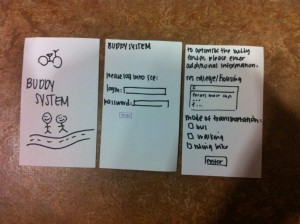
Left: The app cover; Middle: Where the user logs into the ICE network so that the app can access the user’s schedule information; Right: Additional information the user should enter for optimal search results
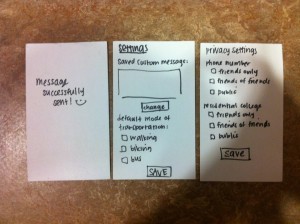
Left: message indicating that the text message was sent successfully; Middle: settings page that user can alter; Right: privacy settings that user can change to make app access less or more of the information they inputted
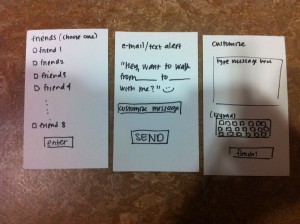
Left: screen allows user to choose a friend that they want to meet up with; Middle: default text message that is sent if user does not customize the screen; Right: option for user to customize the text message they send to friend/new person

Left: user has the choice of what type of buddy he/she wants for the day; Middle: user has the choice of either meeting new people or meeting with their friends; Right: page that indicates what app is doing after the data has been inputted
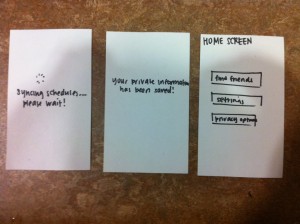
Left: screen that pops up as the device is syncing all user inputted information; Middle: screen that indicates that all the information has been saved successfully; Right: the home screen for the app with the main features
User-Testing

Rishita begins using my social app prototype; she doesn’t immediately know what to do with the title page
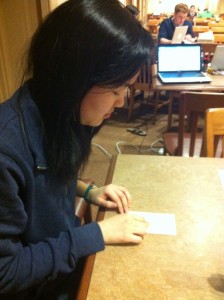
Jean wants a lunch buddy so she selects that option but does not find the appropriate default text message afterwards
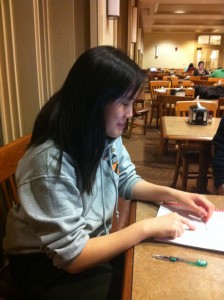
Yolanda wants to meet new people so she selects the find new friends button; the page is a little wordy so she spends some time on the page
Second Prototype

Left: the title page of the app; Middle: user must log into Blackboard so app has user’s class information; Right: main features included in the app

Left: the screen that allows the user to look through the past conversations; Middle: allows user to engage in live conversation with other students in the classroom; Right: interaction screen that pops up as soon as class is scheduled to start

Left: asks user to put in the days and hours that the user is most available to work on problem sets; Middle: app lists all the different students that have similar preferences; Right: using information from Blackboard, the app relays some of the student’s relevant contact information
Insight
I chose to test my buddy system social app with three different users. Every user testing offered some new insight into how I could change the interface for the app. When Rishita tested the application, she would struggle whenever she decided that she wanted to return to the home page and edit the information that she already entered. I realized the importance of making each stage of the app connect to the rest of the screens; this type of setup would allow for a lot more flexibility in accessing old information. Finally, she would often select options that I realized did not need additional pages in the application and in some cases, I had redundant pages (like asking the user their mode of transportation twice). I realized the importance of having relevant information and avoiding redundancy. When Jean tested my interface, she was sitting down to test my prototype. I noticed that the app was actually pretty time consuming, and the process itself took around 1-2 minutes. With respect to the waiting time (10 minutes), 1-2 minutes was actually already pretty time-consuming. This made me wonder whether it was really necessary to add the features where the app would tell the user when something was successfully completed. Again, the idea of redundant information came up. Finally, when Yolanda tested the app, I realized the importance of order. For instance, the text message should be customizable as opposed to set as a default message. This made me start realizing that the order of succession of screens should be very rational and easy to intuitively follow. What I took away from the experience, is that watching users interface with the prototype was extremely useful in understanding the flaws of the app; it also helped me better understand what types of interfaces are more intuitive. If I were going to actually develop an app, I would definitely engage in this prototyping process first.
